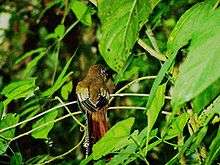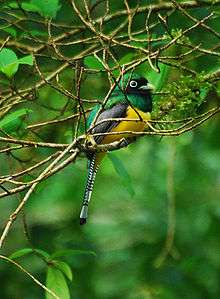Black-throated trogon
The black-throated trogon, also known as yellow-bellied trogon, (Trogon rufus) is a near passerine bird in the trogon family, Trogonidae. Although it is also called "yellow-bellied trogon" it is not the only trogon with a yellow belly. It breeds in lowlands from Honduras south to western Ecuador and northern Argentina.

| Black-throated trogon | |
|---|---|
 | |
| Adult male, Selva Verde Lodge, Costa Rica | |
| Scientific classification | |
| Kingdom: | Animalia |
| Phylum: | Chordata |
| Class: | Aves |
| Order: | Trogoniformes |
| Family: | Trogonidae |
| Genus: | Trogon |
| Species: | T. rufus |
| Binomial name | |
| Trogon rufus Gmelin, 1788 | |
Like most trogons, it has distinctive male and female plumages and with soft colourful feathers. This relatively small species is 23–24 cm long and weighs 54-57 g, with a white undertail with black barring, a yellow bill and wing coverts which are vermiculated with black and white, but appear grey at any distance. The male black-throated trogon has a green head, upper breast and back, black face and throat, and golden yellow belly. The female has a brown head, upper breast and back, rufous upper tail and yellow belly. Immatures resemble the adults but are duller, and young males have a brown throat, breast and wing coverts.
The call is a churring krrrrrr, and the song is a typical trogon series of a few clear whistles, cuh cuh cuh cuh.
It is a resident of the lower levels of damp tropical forests, and prefers the deep shade of the understory. Their broad bills and weak legs reflect their diet and arboreal habits. Although their flight is fast, they are reluctant to fly any distance. They typically perch upright and motionless.
Black-throated trogons feed mainly on arthropods as well as some fruit, often taken in flight; they are one of the most insectivorous trogon species of their range. They opportunistically catch arthropods that have been startled by other predators, such as coatis (Nasua spp.).[2]
The black-throated trogon nests 1–6 m (3.3–19.7 ft) high in an unlined shallow cavity, with a typical clutch of two white eggs.
Footnotes
- BirdLife International (2012). "Trogon rufus". IUCN Red List of Threatened Species. 2012. Retrieved 26 November 2013.CS1 maint: ref=harv (link)
- de Mello Beisiegel (2007), Pizo (2007)
References
- de Mello Beisiegel, Beatriz (2007): Foraging Association between Coatis (Nasua nasua) and Birds of the Atlantic Forest, Brazil. Biotropica 39(2): 283–285 [English with Portuguese abstract]. doi:10.1111/j.1744-7429.2006.00255.x (HTML abstract)
- Hilty, Steven L. (2003): Birds of Venezuela. Christopher Helm, London. ISBN 0-7136-6418-5
- Pizo, Marco Aurélio (2007): The relative contribution of fruits and arthropods to the diet of three trogon species (Aves, Trogonidae) in the Brazilian Atlantic Forest. Revista Brasileira de Zoologia 24(2): 515-517 [English with Portuguese abstract]. doi:10.1590/S0101-81752007000200035 PDF fulltext
- Stiles, F. Gary & Skutch, Alexander Frank (1989): A guide to the birds of Costa Rica. Comistock, Ithaca. ISBN 0-8014-9600-4
| Wikimedia Commons has media related to Trogon rufus. |
